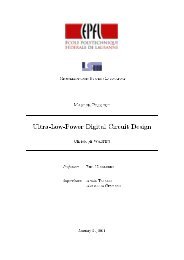Compressive Sensing system for recording of ECoG signals in-vivo
Compressive Sensing system for recording of ECoG signals in-vivo
Compressive Sensing system for recording of ECoG signals in-vivo
Create successful ePaper yourself
Turn your PDF publications into a flip-book with our unique Google optimized e-Paper software.
time, which has been approximated as 33 μs, which is not exactly the <strong>in</strong>verse <strong>of</strong> the sampl<strong>in</strong>gfrequency. In any case, below reconstruction is shown, and it is probed that both <strong>of</strong> thecompressed <strong>signals</strong> give rise a good approximation to the same recovered signal.The reconstruction methods that have been considered are the Basic Pursuit Denois<strong>in</strong>g (BPD)method withand the Least Absolute Shr<strong>in</strong>kage and Selection Operator (LASSO)method with , provided by SPGL1 [30]. They are well-def<strong>in</strong>ed <strong>in</strong> 5.3. The result <strong>of</strong> therecovered signal can be observed <strong>in</strong> Fig.5.1.4 and Fig.5.1.5.Figure 5.1.5. BPDN method reconstruction comparison.5.2. Multi-Channel Implementation <strong>of</strong> <strong>Compressive</strong> <strong>Sens<strong>in</strong>g</strong>Dur<strong>in</strong>g the study <strong>of</strong> the CS applications directly related with the <strong>in</strong>itial purpose <strong>of</strong> the project, thescope <strong>of</strong> CS <strong>system</strong>s which are <strong>in</strong>volved with sparse <strong>signals</strong> <strong>in</strong> time or frequency has spread toa new applicability which can be def<strong>in</strong>ed as Spatial <strong>Compressive</strong> <strong>Sens<strong>in</strong>g</strong>, SCS. The resultsderiv<strong>in</strong>g from this approach has been submitted as publication <strong>in</strong> August 2012. Keep<strong>in</strong>g <strong>in</strong> m<strong>in</strong>dthe huge amount <strong>of</strong> data which are recorded <strong>in</strong> neural arrays and the need to compress it, thesmall area and high <strong>in</strong>tegration <strong>of</strong> the electrodes let a high resolution <strong>of</strong> the bra<strong>in</strong> zone undersignal acquisition, what implies that electrical impulses can be recorded <strong>in</strong> almost a s<strong>in</strong>gleneuron.Due to the sparse nature <strong>of</strong> the spikes which are registered, when a group <strong>of</strong> neurons is active,the surround<strong>in</strong>g groups will be <strong>in</strong>active till the stimulus propagates with certa<strong>in</strong> latency. Thisusual scenery gives rise to some electrodes which are catch<strong>in</strong>g spikes and many others whichare <strong>in</strong>active, so, it is clear to see, that it does exist a spatial sparsity, because at sampl<strong>in</strong>g50















